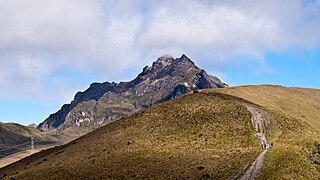
Pichincha is a stratovolcano in Ecuador. The capital Quito wraps around its eastern slopes.
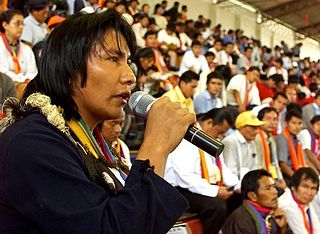
The Sápara, also known as Zápara or Záparo, are an indigenous people native to the Amazon rainforest along the border of Ecuador and Peru. They once occupied some 12,000 mi² between the Napo River and the Pastaza. Early in the 20th century, there were some 200,000 Zapara. From the year 2009 on the Ecuadorian Zápara call themselves Sápara. The official name is Nación Sápara del Ecuador (NASE). It means Sápara Nation of Ecuador. The president of this nation is Klever Ruiz. The Sápara Nation was officially registered by CONDENPE – the Council of Development of the nationalities and peoples of Ecuador – on September 16, 2009. The current name of the organisation is the result of a unification process of upriver and downriver communities. There was a conflict between these different groups about their authentic ethnic identity in the last years of the 20th century and the beginning of the 21st century. With this unification this conflict seems to be solved. CONDENPE confirms as well officially the legal status of autonomy or self-government of the Sápara Nation of Ecuador N.A.S.E. and confirms their territory between the rivers Pindoyacu, Conambo and Alto Corrientes in the province of Pastaza. It is confirmed as well that the head office of NASE is the city of Shell, Pastaza.

Communal work is a gathering for mutually accomplishing a task or for communal fundraising. Communal work provided manual labour to others, especially for major projects such as barn raising, "bees" of various kinds, log rolling, and subbotniks. Different words have been used to describe such gatherings.

Quechua people or Quichua people, may refer to any of the aboriginal people of South America who speak the Quechua languages, which originated among the Indigenous people of Peru. Although most Quechua speakers are native to Peru, there are some significant populations in Ecuador, Bolivia, Chile, Colombia, and Argentina.
The Canelos-Quichua, also known as the Quichua of Pastaza, is an Indigenous people of Ecuador. They are a Lowland Quichua people, inhabiting the province of Pastaza on the banks of the Curaray, Bonbonaza, and Pastaza rivers, in Peru and Ecuador.
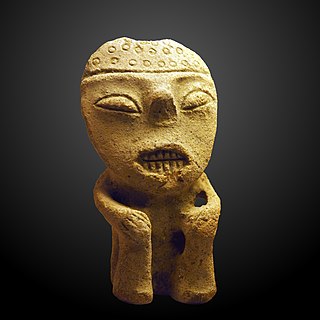
The Chullachaki or Chullachaqui, also known as the Shapishico, is a mythical forest creature of the Peruvian and Brazilian Amazonian jungle.

Sarayaku is a territory and a village situated by the Bobonaza River in the province of Pastaza in the southern part of el Oriente, the Amazonic region of Ecuador. The territory incorporates a number of villages.
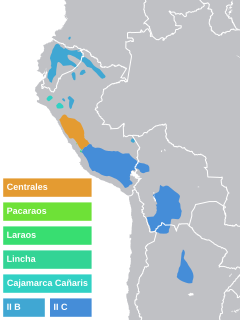
Kichwa is a Quechuan language that includes all Quechua varieties of Ecuador and Colombia (Inga), as well as extensions into Peru. It has an estimated half million speakers.

Media Lengua, also known as Chaupi-shimi, Chaupi-lengua, Chaupi-Quichua, Quichuañol, Chapu-shimi or llanga-shimi, is a mixed language with Spanish vocabulary and Kichwa grammar, most conspicuously in its morphology. In terms of vocabulary, almost all lexemes (89%), including core vocabulary, are of Spanish origin and appear to conform to Kichwa phonotactics. Media Lengua is one of the few widely acknowledged examples of a "bilingual mixed language" in both the conventional and narrow linguistic sense because of its split between roots and suffixes. Such extreme and systematic borrowing is only rarely attested, and Media Lengua is not typically described as a variety of either Kichwa or Spanish. Arends et al., list two languages subsumed under the name Media Lengua: Salcedo Media Lengua and Media Lengua of Saraguro. The northern variety of Media Lengua, found in the province of Imbabura, is commonly referred to as Imbabura Media Lengua and more specifically, the dialect varieties within the province are known as Pijal Media Lengua and Angla Media Lengua.
Paccha is a town and parish in Cuenca Canton, Azuay Province, Ecuador. The parish covers an area of 25.6 km2 and according to the 2001 Ecuadorian census it had a population total of 5,311.
Amazonian Kichwas are a grouping of indigenous Kichwa peoples in the Ecuadorian Amazon, with minor groups across the borders of Colombia and Peru. Amazonian Kichwas consists of different ethnic peoples, including Napo Kichwa and Canelos Kichwa. There are approximately 419 organized communities of the Amazonian Kichwas. The basic socio-political unit is the ayllu. The ayllus in turn constitute territorial clans, based on common ancestry. Unlike other subgroups, the Napo Kichwa maintain less ethnic duality of acculturated natives or Christians.
Intercultural bilingual education(Educación bilingüe intercultural) is a language-planning model employed throughout Latin America in public education, and it arose as a political movement asserting space for indigenous languages and culture in the education system. IBE is designed to address the educational needs of indigenous communities, and consists of various bilingual curriculum designs.
Huasipungo is a 1934 novel by Jorge Icaza (1906-1978) of Ecuador.
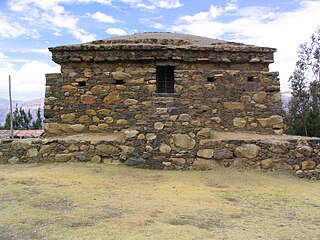
Wilcahuaín, Willcahuaín, or Huilcahuaín is an archaeological site in Peru. It is located near the village of Paria, 7 km northwest of the city of Huaraz, Ancash; at an elevation of 3,400 m (11,200 ft).
Mallkuamaya is an archaeological site in Peru. It is located in the Puno Region, Puno Province, Puno District, about 15 km southwest of Puno. The site was declared a National Cultural Heritage (Patrimonio Cultural) of Peru by the National Institute of Culture.
Inka Tunuwiri is an archaeological site in Peru. It is located in the Puno Region, Puno Province, between the districts Chucuito and Puno, southeast of the village Ichu. Inka Tunuwiri was declared a National Cultural Heritage (Patrimonio Cultural) of Peru by the National Institute of Culture.

Mikakucha is a lake in the Napo Province in Ecuador. It is situated in the Antisana Ecological Reserve, southwest of the volcano Antisana.
Yana Urqu or Yana Urku may refer to:
Runa Foundation is a public, non-profit organization with offices in Brooklyn, NY; Quito, Ecuador; Archidona, Ecuador; and Tarapoto, Peru. Runa Foundation's stated mission is to "create new value for tropical forests that benefit local people and the forest ecosystem". Runa Foundation is a 501(c)3 non-profit corporation registered in the state of Rhode Island.











